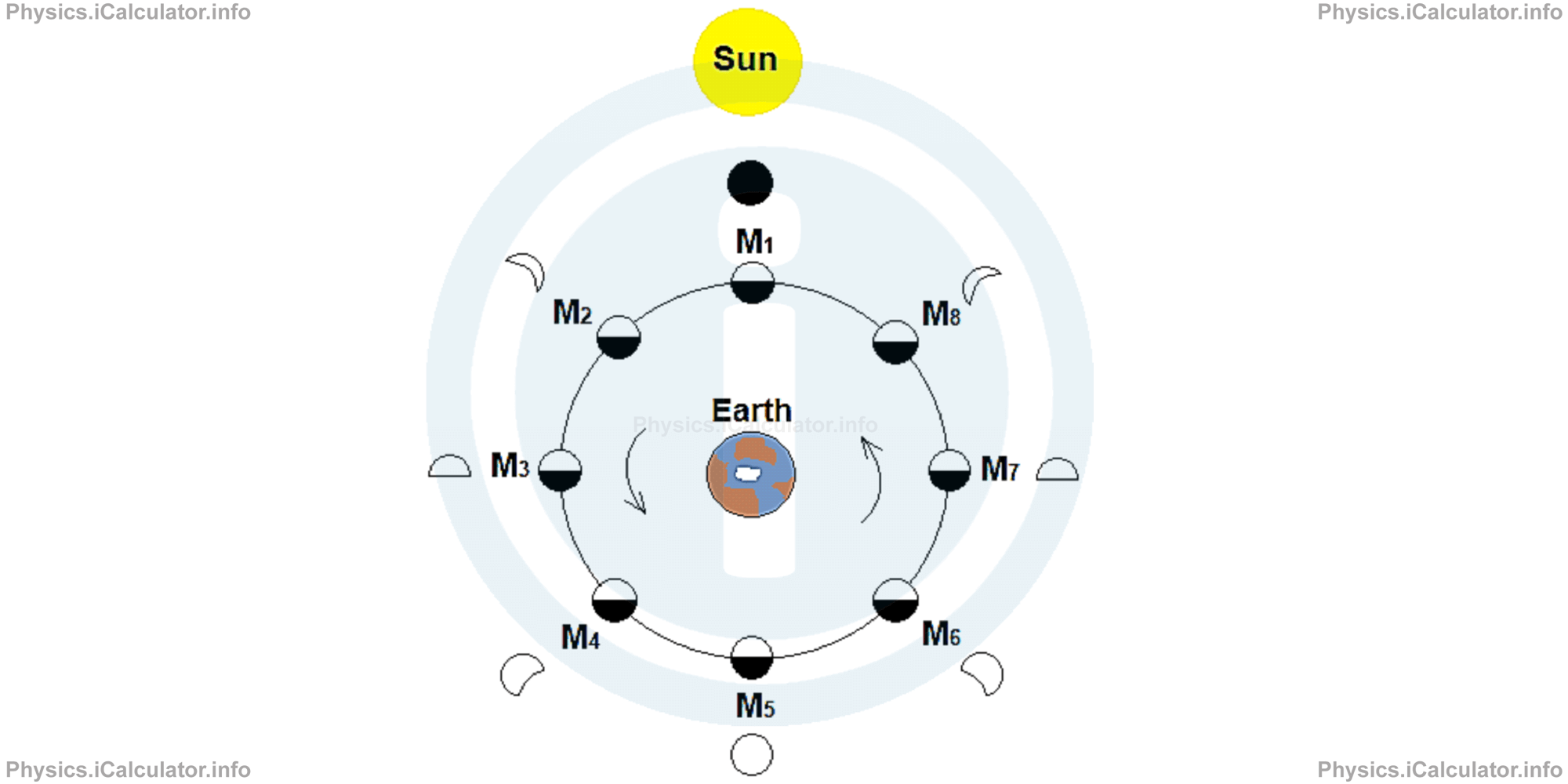Menu
Physics Lesson 22.3.2 - Moon Phases
Please provide a rating, it takes seconds and helps us to keep this resource free for all to use
Welcome to our Physics lesson on Moon Phases, this is the second lesson of our suite of physics lessons covering the topic of The Moon's Movement. Eclipses. Calendars, you can find links to the other lessons within this tutorial and access additional physics learning resources below this lesson.
Moon Phases
Like all the other celestial bodies (except stars), the Moon does not produce light by itself. It only reflects the light incident from the Sun, which always illuminates only half of the Moon. This illuminated part looks different in various periods of the month depending on the position of the Moon. This different view of the the Moon from the Earth at different times of the lunar month determines the Moon's phases. The figure below clarifies this point. Aside each Moon position there is another figure, which shows how the Moon looks at that stage when viewed from Earth.

The names of the eight phases of Moon are, in order, new Moon (M1), waxing crescent (M2), first quarter (M3), waxing gibbous (M4), full Moon (M5), waning gibbous (M6), third quarter (M7) and waning crescent (M8).
When the Moon is at position M1, it is not visible from Earth. This stage is known as "new moon".
When the Moon is at position M2, only a small portion of the Moon is visible from Earth.
When the Moon is at position M3, there is half of it visible from Earth. This stage is known as "half-moon".
When the Moon is at position M4, there is more than half of it visible from Earth.
When the Moon is at position M5, the entire bright side of it is visible from Earth.
When the Moon is at position M6, the image viewed from earth is similar to M4.
When the Moon is at position M7, the image viewed from earth is similar to M3 (half-moon).
When the Moon is at position M8, the image viewed from earth is similar to M2.
When the Moon is at its initial position (M1), the new lunar month starts.
Thus, depending on the position of the Moon, its appearance changes when viewed from Earth. In the position 2 and 8 it looks like a sickle, while in positions 4 and 6 it looks like a bitten orange and so on.
Besides the orbital revolution, the Moon rotates around its own axis as well. This rotation occurs at the same period as the period of revolution around the Earth (in one synodic month). This is the reason why the Moon always shows the same face to Earth. As we have explained in the previous tutorial, all natural satellites manifest the same behavior except Hyperion (one of natural satellites of Saturn). This coincidence in periods derives from the fact that the Earth and the Moon are both massive objects that don't have a very large distance between them - a fact that prevents us from considering the Moon as a point object. The gravitational force exerted by Earth on the Moon produces a moment that makes the two abovementioned periods equal. This equalization has been achieved after millions of years of Earth-Moon coexistence. Tides represent a similar effect but this time exerted by the Moon on Earth.
You have reached the end of Physics lesson 22.3.2 Moon Phases. There are 5 lessons in this physics tutorial covering The Moon's Movement. Eclipses. Calendars, you can access all the lessons from this tutorial below.
More The Moon's Movement. Eclipses. Calendars Lessons and Learning Resources
Whats next?
Enjoy the "Moon Phases" physics lesson? People who liked the "The Moon's Movement. Eclipses. Calendars lesson found the following resources useful:
- Phases Feedback. Helps other - Leave a rating for this phases (see below)
- Cosmology Physics tutorial: The Moon's Movement. Eclipses. Calendars. Read the The Moon's Movement. Eclipses. Calendars physics tutorial and build your physics knowledge of Cosmology
- Cosmology Revision Notes: The Moon's Movement. Eclipses. Calendars. Print the notes so you can revise the key points covered in the physics tutorial for The Moon's Movement. Eclipses. Calendars
- Cosmology Practice Questions: The Moon's Movement. Eclipses. Calendars. Test and improve your knowledge of The Moon's Movement. Eclipses. Calendars with example questins and answers
- Check your calculations for Cosmology questions with our excellent Cosmology calculators which contain full equations and calculations clearly displayed line by line. See the Cosmology Calculators by iCalculator™ below.
- Continuing learning cosmology - read our next physics tutorial: Stars
Help others Learning Physics just like you
Please provide a rating, it takes seconds and helps us to keep this resource free for all to use
We hope you found this Physics lesson "The Moon's Movement. Eclipses. Calendars" useful. If you did it would be great if you could spare the time to rate this physics lesson (simply click on the number of stars that match your assessment of this physics learning aide) and/or share on social media, this helps us identify popular tutorials and calculators and expand our free learning resources to support our users around the world have free access to expand their knowledge of physics and other disciplines.